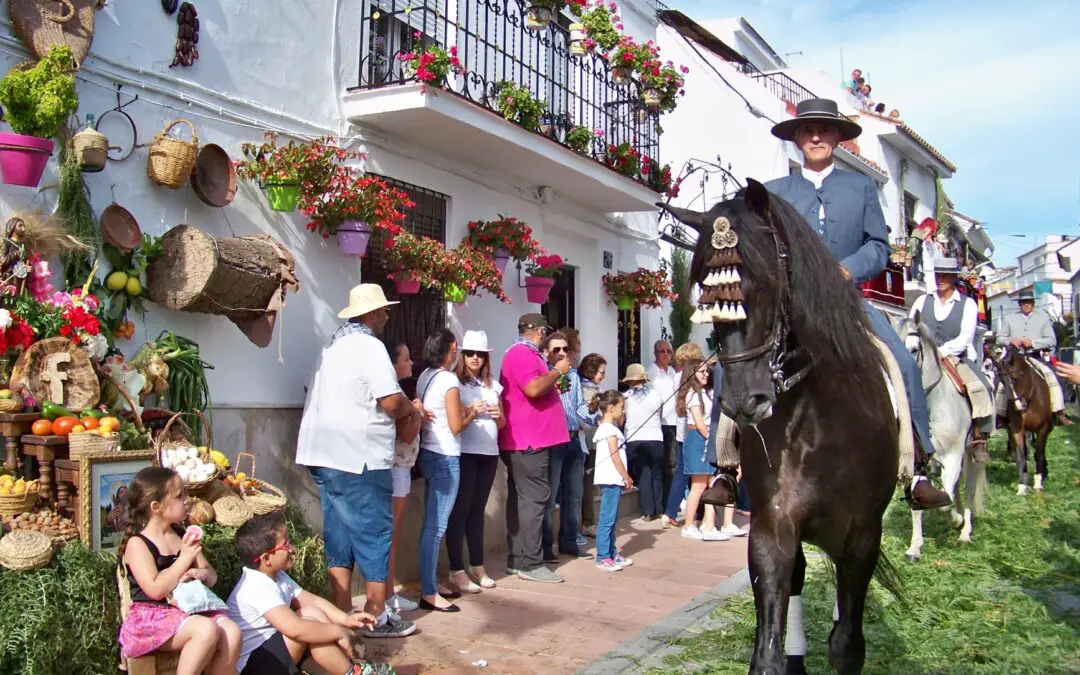Estepona is a town that was traditionally divided between the fishermen’s quarter and the farmers’ quarter. For this reason, the patron saints of Estepona are the Virgen del Carmen (who takes care of fishermen) and San Isidro Labrador (patron saint of farmers). In this article we are going to talk about the latter and the traditions and customs around the Feria Chica.
When is the Feria Chica held?
The feast of San Isidro is highly anticipated by the Esteponeros, as it is the first major festival held in the town and coincides with the good weather. This festival is also known as “la feria chica”, since in addition to the religious traditions associated with this festivity, from May 10 to May 15, there are attractions for children and adults, as well as booths where you can dance and eat at the fairgrounds every afternoon.
When do you go on romería?
This is a country party and it shows. On Sunday May 7 there is a pilgrimage scheduled by the Brotherhood of San Isidro Labrador to take the saint to the hermitage of Los Pedregales, where you can find a bar with drinks and food to celebrate. In the past it was allowed to camp those days in Los Pedregrales and dance until the wee hours of the morning. There are also contests and exhibitions related to animals and customs of the countryside that you can read about here:
The days of celebration end with the expected procession with horses, tractors and farm machinery through the streets of the old town of Estepona.
The celebration of San Isidro in Estepona: unique customs and traditions.
In this article we will explore the customs and traditions that make the celebration of San Isidro Labrador a unique and special event in Estepona. On May 15, the streets of the neighborhood of El Cristo and its surroundings are decorated with a carpet of flowers and fragrant plants from the fields of Estepona all over the ground. During that day, horses with Andalusian bearing are paraded through the streets, culminating in a cavalcade full of pilgrims on floats pulled by tractors.

1- Traditional costumes.
The youngest girls are usually dressed in the traditional villager dress, which consists of a bodice, apron, blouse, petticoat, polo shirt and scarves. I remember everything was endless laces, especially in the espadrilles they used to put on us. The girls usually carry a wicker basket with fruits.
Children and adults, both men and women, you will see them dressed in campero clothes: jeans, white t-shirt and blue checkered bandana. And if you do not want to miss any item of clothing, you also need a vest, sash and cap. It is an outfit that illuminates the streets of Estepona.

2- Country huts and altars.
One of the most beautiful and traditional streets is Casares Street. One of his emblematic ranches, which is no longer in use, was the Horno hut. Through these streets the gates decorated with green branches from the countryside were opened. Nowadays, groups of friends get together to set up their own hut, decorated with country instruments. The huts are born to open the house to friends and family and celebrate the fact that Estepona is the countryside, and it shows.
These streets are also filled with different altars with the figure of the patron saint and show the products of the land, tools and utensils of the field.
3- Country soup and sangria.
In every hut you can not miss the “sopa campera” accompanied by a refreshing sangria with peaches and lemons from Estepona. The “sopa campera” was a meal of humble families that was made with bread in a pot where a ratatouille of onion, tomato and bell pepper was poured, and finally an egg was broken on top. This food is now traditional, smells like the countryside and takes you to your innermost feelings just by taking a spoonful.
If you are interested in the gastronomy of this land, we recommend you to read this other article: What to eat typical of Estepona. Enjoy!
4- Fruit basket.
On the floats, the members carry wicker baskets with typical fruits. Cherries, peaches, strawberries and loquats are a must.
I remember when I was a child I used to ride on them and go around handing out fruit to those who accompanied us on foot or watching the carts go by. Even now, when I eat a loquat or a peach from my father’s field, I am able to remember when I was dressed as a villager and riding in the carriage. Traditional festivals make us travel back in time!
5- VIVA SAN ISIDRO!
In the streets of Estepona, on May 15, on every corner, there will be someone shouting at the top of their lungs in praise of this saint: VIVA SAN ISIDRO! And right after this shout, his friends and the pilgrims who walk through the streets will answer: VIVA, without hesitation. This shout of joy makes you feel that you live in community and that the people around you have the same feeling as you.
Undoubtedly, the so-called “small fair” is the big party of the “camperos” and “esteponeros”. The streets of Estepona are transformed into a field that day. If you would like to visit the Costa del Sol Garden on these dates it will be important to book in advance. If you are looking for a charming hotel or accommodation to go with your family, in the links you will find some recommendations. I hope you enjoy the party and shout many times VIVA SAN ISIDRO!


